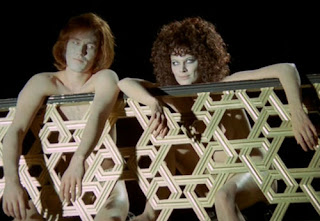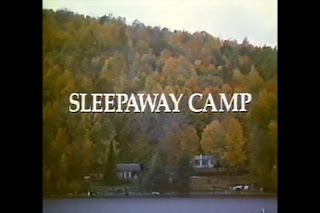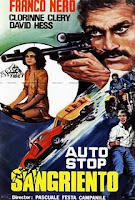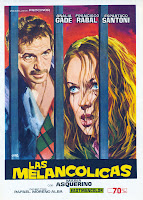The first Penitentiary made enough money that funding came through for a sequel and Jamaa Fanaka is a director who loves to work. Thus we have Penitentiary 2, basically a repeat of the first movie set outside of an actual penitentiary. Leon Isaac Kennedy returns as Martell 'Too Sweet' Gordone, trying to make a new life for himself after having boxed his way out of prison and trying to avoid being pulled into the world of professional boxing. As you might guess, he winds up pulled into the world of professional boxing. His opponent from the first movie, Jessie “the Bull” (Donovan Womack) is his opponent here, and his enemy Half Dead returns, this time having escaped from the law and played by Ernie Hudson of Ghostbusters fame. His old trainer Seldom Seems (Malik Carter) returns as well, although with considerably less pep than in the first film, owing perhaps to Carter’s reputed drug problems.
Much of the continuing storyline is set up via an opening scrawl in the style of
Star Wars, an obvious homage that suggests the influence of the Lucas film on Fanaka’s own filmmaking. He seems to be tipping his hat to the huge influence that the
Star Wars films had on American cinema in general and this film seems more like a crowd pleaser, with music often signaling the audience’s emotions and the storyline simpler than before, more spelled out through the dialogue. It’s a bit dumbed down, just like the Lucas movies. The impact of the
Star Wars trilogy on cinema is apparent, but it’s not exactly been good.
What’s frustrating about Penitentiary 2 is that it begins with a story focusing on the great theme in Jamaa Fanaka’s work: an average black man struggling to have a stable life in adverse conditions, only to abandon it. Too Sweet is struggling with the pain of having lost his parents in a car accident, doing jail time for a crime he didn’t commit, and trying to readjust to the outside world. He has reconciled with his old girlfriend Clarisse (Eugenia Wright) and is working a delivery job to meet the terms of his parole. But this is all derailed by the psychotic Half Dead (Ernie Hudson) who wants revenge on Too Sweet and gets it by raping and killing Clarisse before a long brawl that is only stopped by the police before Too Sweet can kill him- an obvious replay of the brutal fight the two characters had in the first movie, at almost exactly the same point in the story.
Luckily, Fanaka knows it would be absurd to send Too Sweet back to jail for defending his home. Instead, he uses the killing as the catalyst that sends Too Sweet back to the ring. There are two problems with this. First, he has Kennedy announce his intentions to box in a speech that again assumes the audience has to be told everything:
“I’m going to box… I’m going to be somebody… I’m going to get respect. I’m going to talk to the kids about the insanity in this world. I’m going to make a difference in this dirty rotten world. I’m going to do it for Clarisse. I’m going to be champion of the world.” We could have probably figured this out without being told. Secondly, the murder of Clarisse doesn’t interfere in the story too much: a few scenes later, Too Sweet and Seldom Seems are picking up cute girls in a disco. It never seems like the rape and murder of his true love has much emotional impact on Too Sweet, which it probably should.
Too Sweet has to prove himself by fighting Jessie the Bull, with the match strangely taking place in the penitentiary. The boxing is shot well and Fanaka is much-improved as a director. As with the first film, there are plenty of colorful characters, from Half Dead's sidekicks Do Dirty and Simple to Too Sweet's new trainer, played by Mr. T in his first screen appearance. There are also great cameos by fighter Archie Moore and the great Rudy Ray Moore. And the conclusion is rousing.
But there's a rushed quality to the film that leaves some logical gaps: Half Dead never ends up fighting Too Sweet in the end and Jessie "the Bull" has almost no screen time outside of the bouts- it gives the impression that the true story hasn't happened. There's also the matter of the quickly forgotten dead Clarisse. At the end, I have mixed feelings about this movie. It's definitely a crowd pleaser and a rousing film. Jamaa Fanaka is a solid commercial director. But I wish someone would give him the money necessary to make a movie that's both exciting and as weird and radical as his earlier films. Otherwise, it's like Half Fanaka, and cinema needs the man giving us all his heart and soul.
 When it comes to the exploitation and grindhouse movies that horror filmmakers are trying to emulate currently, Italy really was the world leader. Sure, there are some amazing exploitation movies from Indonesia and the US and I'm just now discovering Canadian exploitation, but goddamn did the Italians do it sleazier, bloodier, and nudier than anyone else.
When it comes to the exploitation and grindhouse movies that horror filmmakers are trying to emulate currently, Italy really was the world leader. Sure, there are some amazing exploitation movies from Indonesia and the US and I'm just now discovering Canadian exploitation, but goddamn did the Italians do it sleazier, bloodier, and nudier than anyone else.






























